Total Pageviews
Monday, August 27, 2012
Friday, July 13, 2012
The Pinterest effect
on e-commerce sites continues: online wine retailer Wine.com, a company
with $67 million in annual revenue, is adding a social shopping
component to its website which not only looks like Pinterest, but is
also powered by Facebook. Wine.com says it’s using technology provided by Sociable Labs, a San Francisco-based startup which introduced its licensable “EverShare” product suite earlier this year.
But while Wine.com’s change is a notable one for them, the bigger story here is the traction that Sociable Labs is seeing, thanks to the “Pinterestification” (not a real word!) of e-commerce.
 As a refresher, EverShare
lets companies host their own Pinterest-style product pages on their
websites, while also connecting with Facebook APIs to allow things like
purchases, comments, and reviews to be shared with customers’ Facebook
friends. It’s the kind of thing that could have been a Pinterest
platform app, if Pinterest had a public API. But instead, the service
gives sites the “Pinterest feel,” as well as the Facebook graph – an
interesting and insanely practical combo.
As a refresher, EverShare
lets companies host their own Pinterest-style product pages on their
websites, while also connecting with Facebook APIs to allow things like
purchases, comments, and reviews to be shared with customers’ Facebook
friends. It’s the kind of thing that could have been a Pinterest
platform app, if Pinterest had a public API. But instead, the service
gives sites the “Pinterest feel,” as well as the Facebook graph – an
interesting and insanely practical combo.
On Wine.com’s site, for example, the implementation of Sociable’s technology allows visitors to visually browse through products, and, if they’re also connected to Facebook, they can instantly share their activity through Facebook’s Open Graph and see what their friends have recently purchased. There are also some handy customizations provided by Sociable Labs. For example, purchases with a gift message are never shared to Facebook so the surprise won’t be ruined. And there’s a box on the order confirmation page that lets customers post directly from checkout to Facebook.
But rollouts like this are risky. Wine.com didn’t do a big announcement, because the implementation is in beta. As I go to publish this, the EverShare-enabled Live Feed is down (the company says it’s doing “PCI compliance scans.” Oops.) Still, what do Wine.com’s customers think when a big part of the website is dead? Ideally, the best bet may be to make visual, social shopping a core part of the business, like Fab.com has, as opposed to a third-party integration. But not all merchants have the time or resources to make that happen. And maybe they’re not convinced that they should.
Sociable Labs’ CEO Nisan Gabbay says his company now has over 20 customers deployed or in process of deploying the EverShare feature set. And it’s not always e-commerce sites, as it turns out. “We’ve seen equally great response from prominent media companies, in addition to online retailers,” he notes. “As a result, we’ve doubled the size of our sales and services team over the last few months,” Gabbay says. However, because of agreements with customers, most don’t allow Sociable to publish specifics. The only others besides Wine.com which Gabbay could share are Charlotte Russe, Sole Society, Glyde, Rue La La, and Totsy.
The average monthly license fee for the EverShare software and accompanying analytics service is $6,000 per month, Gabbay tells us, and is determined by customer size. If visual browsing is the future of e-commerce and beyond, companies like his could be a big deal.
EverShare, remember, launched in February, so it’s a very new product – those 20 some brands are definitely early adopters here.
Meanwhile, Pinterest itself is proving hugely influential in consumer online shopping behavior. According to new data from Compete, in a small survey, 31% of shoppers said that seeing a “pin” on Facebook influenced them to consider a brand and 25% said that seeing pins on Pinterest said it was used for discovery. Meanwhile, 8% on Pinterest and 5% on Facebook said the pin actually led to purchase.

But Compete points out that brands have been slow to engage on Pinterest, and wondered what the holdup may be. The lack of a proper API platform is likely a good guess. This stuff is difficult track. And, as with TV or magazine ads, it’s hard to know when exposure to imagery and content inspires a purchase further down the road…or even a “good feeling” about a brand. Measuring the true ROI of “pinning” behaviors, whether Pinterest proper or Pinterest-like (e.g. EverShare), is going to take some time. It’s the wild, wild west out there.
However, the “right” strategy, like most things in this space, is not going to be a one-size fits all solution, though. For some, EverShare could be an easy way to boost social engagement, while others will want to engage more directly on Pinterest itself. And for others still, they may go for a mix of solutions. Whatever the result, “Pinterestification” of shopping, and maybe even discovery itself is coming.
Source : http://goo.gl/hTUIJ / techcrunch.com/
But while Wine.com’s change is a notable one for them, the bigger story here is the traction that Sociable Labs is seeing, thanks to the “Pinterestification” (not a real word!) of e-commerce.
 As a refresher, EverShare
lets companies host their own Pinterest-style product pages on their
websites, while also connecting with Facebook APIs to allow things like
purchases, comments, and reviews to be shared with customers’ Facebook
friends. It’s the kind of thing that could have been a Pinterest
platform app, if Pinterest had a public API. But instead, the service
gives sites the “Pinterest feel,” as well as the Facebook graph – an
interesting and insanely practical combo.
As a refresher, EverShare
lets companies host their own Pinterest-style product pages on their
websites, while also connecting with Facebook APIs to allow things like
purchases, comments, and reviews to be shared with customers’ Facebook
friends. It’s the kind of thing that could have been a Pinterest
platform app, if Pinterest had a public API. But instead, the service
gives sites the “Pinterest feel,” as well as the Facebook graph – an
interesting and insanely practical combo.On Wine.com’s site, for example, the implementation of Sociable’s technology allows visitors to visually browse through products, and, if they’re also connected to Facebook, they can instantly share their activity through Facebook’s Open Graph and see what their friends have recently purchased. There are also some handy customizations provided by Sociable Labs. For example, purchases with a gift message are never shared to Facebook so the surprise won’t be ruined. And there’s a box on the order confirmation page that lets customers post directly from checkout to Facebook.
But rollouts like this are risky. Wine.com didn’t do a big announcement, because the implementation is in beta. As I go to publish this, the EverShare-enabled Live Feed is down (the company says it’s doing “PCI compliance scans.” Oops.) Still, what do Wine.com’s customers think when a big part of the website is dead? Ideally, the best bet may be to make visual, social shopping a core part of the business, like Fab.com has, as opposed to a third-party integration. But not all merchants have the time or resources to make that happen. And maybe they’re not convinced that they should.
Sociable Labs’ CEO Nisan Gabbay says his company now has over 20 customers deployed or in process of deploying the EverShare feature set. And it’s not always e-commerce sites, as it turns out. “We’ve seen equally great response from prominent media companies, in addition to online retailers,” he notes. “As a result, we’ve doubled the size of our sales and services team over the last few months,” Gabbay says. However, because of agreements with customers, most don’t allow Sociable to publish specifics. The only others besides Wine.com which Gabbay could share are Charlotte Russe, Sole Society, Glyde, Rue La La, and Totsy.
The average monthly license fee for the EverShare software and accompanying analytics service is $6,000 per month, Gabbay tells us, and is determined by customer size. If visual browsing is the future of e-commerce and beyond, companies like his could be a big deal.
Should Retailers Go “Pinterest-Like” Or Pinterest Proper?
But retailers are going to soon have to make some tough decisions. Should they build visual, social shopping in-house, integrate directly with Pinterest and use third-party analytics offerings, or should they integrate a third-party Pinterest-like technology (like EverShare and its accompanying analytics reporting)? What’s the right answer?EverShare, remember, launched in February, so it’s a very new product – those 20 some brands are definitely early adopters here.
Meanwhile, Pinterest itself is proving hugely influential in consumer online shopping behavior. According to new data from Compete, in a small survey, 31% of shoppers said that seeing a “pin” on Facebook influenced them to consider a brand and 25% said that seeing pins on Pinterest said it was used for discovery. Meanwhile, 8% on Pinterest and 5% on Facebook said the pin actually led to purchase.

But Compete points out that brands have been slow to engage on Pinterest, and wondered what the holdup may be. The lack of a proper API platform is likely a good guess. This stuff is difficult track. And, as with TV or magazine ads, it’s hard to know when exposure to imagery and content inspires a purchase further down the road…or even a “good feeling” about a brand. Measuring the true ROI of “pinning” behaviors, whether Pinterest proper or Pinterest-like (e.g. EverShare), is going to take some time. It’s the wild, wild west out there.
Workarounds For The Pinterest Problem
However, workarounds for the Pinterest problem are already starting to emerge. Curalate and Pintics offer analytics, for example. Lexity is introducing a new app tomorrow that lets merchants see how the products they carry are trending on Pinterest, and which are most popular. It’s also helping to discover the top influencers on the platform, as related to the products they sell. (Other apps have already emerged in the “pinfluence” space, like Pinclout and Pinpuff.) But Lexity’s offering lets retailers really start taking action on Pinterest – businesses and brands can download top pins, influencers, find and follow the right people and the right boards, pin their top products automatically, track revenue generated by pins and more.However, the “right” strategy, like most things in this space, is not going to be a one-size fits all solution, though. For some, EverShare could be an easy way to boost social engagement, while others will want to engage more directly on Pinterest itself. And for others still, they may go for a mix of solutions. Whatever the result, “Pinterestification” of shopping, and maybe even discovery itself is coming.
Source : http://goo.gl/hTUIJ / techcrunch.com/
Friday, July 6, 2012
Mysterious bacteria near Easter Island statues offer cure for Alzheimers

Please don't
forget to:
July 4, 2012 - A natural drug discovered in the soil of Easter Island could improve the memory of older men and women - and even treat Alzheimer's, researchers say.forget to:
In tests in mice, the drug halted the decline in brain function as they got older, and supplied hope that it could also treat depression.
The drug - rapamycin - is a bacterial by-product discovered in the shadows of the island's popular statues.
It is named after Rapa Nui, the Polynesian name for Easter Island, which sits isolated in the Pacific ocean - 2000 miles from anywhere.
Easter Island heads: It is named after Rapa Nui, the Polynesian name for Easter Island, which sits isolated in the Pacific ocean - 2000 miles from anyplace
It is already utilized in transplant patients to avoid organ rejection and now scientists in journal Neuroscience say it can increase understanding and assist treat cognitive decline.
It could even treat situations like Alzheimer's, they believe.
A team from the University of Texas added the drug to the diet of healthy mice and discovered it enhanced learning and memory in young mice and memory in elder rodents.
Professor Veronica Galvan said: ‘We made the young ones discover, and bear in mind what they learned, far better than what is standard.
‘Among the older mice, the ones fed with a diet plan like rapamycin really showed an improvement, negating the normal decline that you see in these functions with age.’
The team also identified three ‘happy, feel-good’ neurotransmitters - serotonin, dopamine and norepinephrine - had been higher in the mice treated with rapamycin.
This could help clarify the effects on memory, she said, and helped back up earlier research which showed Alzheimer's like syndromes had been lowered in mice treated with the drug.
‘This is super-intriguing and one thing we are going to pursue in the lab,’ she stated.
It also lowered anxiety and depressive-like behaviour in the mice, she said.
Her colleague Dr Jonathan Halloran utilized a series of elevated tunnels that led to a catwalk to examine the behaviour of the rodents.
Mice prefer tunnels to open spaces and had been watched on the catwalk.
Dr Halloran mentioned: ‘All of a sudden the mice are in open space.
‘It's pretty far from the floor for their size, sort of like if a particular person is hiking and suddenly the trail gets steep. It really is pretty far down and not so comfortable.’Mice with much less anxiety were a lot more curious to discover the catwalk, he stated.
He explained: ‘We observed that the mice fed with a diet containing rapamycin spent significantly a lot more time out in the open arms of the catwalk than the animals fed with a regular diet plan.’
Similarly, when mice had been handled by their tails they would struggle, but depressed mice would struggle less.
‘So we can measure how considerably and how typically they struggle as a measure of the motivation they have to get out of an uncomfortable circumstance,’ said Dr Galvan.
‘We discovered rapamycin acts like an antidepressant - it increases the time the mice are attempting to get out of the scenario. ‘They don't give up they struggle far more.
Sources and more information:
• Mysterious bacteria found in soil near Easter Island statues could offer cure for Alzheimers
A
natural drug discovered in the soil of Easter Island could improve the
memory of older people - and even treat Alzheimer's, researchers say.
In tests in mice, the drug halted the decline in brain function as they
got older, and offered hope that it could also treat depression.
The drug - rapamycin - is a bacterial by-product discovered in the...
• Does Easter Island hold the secret of reversing Alzheimer's Disease? [Neuroscience]
The
drug rapamycin comes from bacteria found in the soils of Easter Island.
It's helped save lives for over a decade by preventing rejection in
organ transplants, but that might just be scratching the surface of what
it can do.
Rapamycin takes its name from Rapa Nui, the island's name in the native
Eastern Polynesian language.
• Does Easter Island Hold Alzheimer's Cure?• Easter Island may hold the key to curing Alzheimer's
• Rapamycin Raises Cognition Throughout Life Span In Mouse Model
• Does Easter Island Hold Keys to Solving Alzheimer?
Source : http://www.disclose.tv/news/Mysterious_bacteria_near_Easter_Island_statues_offer_cure_for_Alzheimers/85496
Monday, July 2, 2012
Tuesday, April 24, 2012
Pinterest – The Value Of Pinterest to Hotel Sales & Marketing
April 19, 2012 By staywyse
Is Pinterest just latest ‘shiny new toy’ or will it have staying power?In February Pinterest drove more traffic to websites than Twitter, Google+, LinkedIn (LNKD), and YouTube combined. (HotelMarketing.com, 3/26/12). Couple that statistic with the fact that 93% of its users are females, and you have a powerful tool for the leisure and social market. It only took 9 months for Pinterest to go from 50,000 users to 17 million – it took Facebook 16 months. (commsource)
Pinterest formerly told its users to not use the site for self promotion and pin stuff they found on other sites. This lead to a potential copyright infringement issue as many photos are copyright protected to their photographers. Pinterest changed its user agreement to encourage ‘pinners’ to post their own photos and other ‘stuff’ thus opening the flood gates for business use. (WSJ, 3/26/12)
In an article entitled Is Pinterest the New Facebook (Jessi Hemple, Fortune Magazine, 3/22/12) differentiated the two in the following manner. “People use Facebook and Twitter to talk to each other, not necessarily to discuss things they might want to buy. In contrast, Pinterest users are more often in a shopping mindset when they are using the service. If you’re keeping a pinboard called “Spring handbags I’m considering,” there’s a good chance you’ll click through and make a purchase.”
What you pin on Pinterest should support and enhance your brand. Pinterest is all about envisioning an experience and that dovetails nicely with the emphasis in hospitality on creating guest experiences rather just ‘selling’ them a room. It also is purely visual which eliminates the marketers’ adjectives in copy that the customer has long since stopped believing. Pinterest creates a sense of place and helps visitors to the site visualize experiences they may have at the hotel – they can put themselves in the pictures.
However, like all social media, a strategy for what the property wants to accomplish with the page needs to be in place prior to engaging and not just ‘pinning’ everything from the web site or Facebook. Pinterest to be used well should also focus on the destination as well as the property. “ When it comes to pinning, the breakdown will be approximately 70% about the city and 30% about the hotel, (Kelli) Crean (ecommerce manager for the Roosevelt Hotel) said.” (HotelNewsNow, 3/28/12)
Pinterest is perfect for all types of properties but it, like Facebook, levels the playing field between the boutique, lifestyle and independent hotels and the large chains.
Source http://staywyse.org/2012/04/19/pinterest-the-value-of-pinterest-to-hotel-sales-marketing/
Tuesday, January 31, 2012
The Dropa Stone Discs
The Dropa Stone Discs
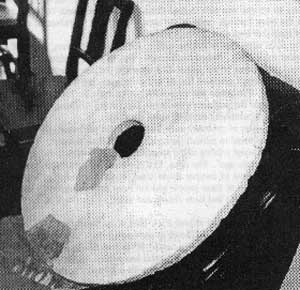
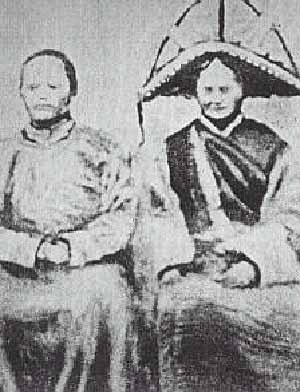
Who were the Dropa? The Dropa (also known as Dropas, Drok-pa or Dzopa) are, according to certain controversial writers, a race of dwarf-like extraterrestrials who landed near the Chinese-Tibetan border some twelve thousand years ago. Skeptics note, however, a number of problems with the case (and a lack of corroborative evidence), which offers significant doubt as to the reality of the more sensationalistic Dropa claims. Mainstream critics argue that the entire affair is a hoax.
Alleged Discovery -- Chi Pu Tei, a professor of archaeology at Beijing University, and his students were on an expedition to explore a series of caves in the pathless Himalayan mountains of the remote Bayan-Kara-Ula in Qinghai on the border of China and Tibet. The caves may have been artificially carved to be a system of tunnels and underground storerooms. The walls were squared and glazed, as if cut into the mountain with great heat.
They found many neat rows of tombs with short 4 ft 4 in inch skeletons buried within. The skeletons had abnormally big heads, and small, thin, fragile bodies. A member of the team suggested that these might be the remains of an unknown species of mountain gorilla. Prof. Chi Pu Tei was said to respond, "Who ever heard of apes burying one another?"
There were no epitaphs at the graves, but instead hundreds of one foot wide stone discs ("Dropa Stones") were found having 3/4 inch wide holes in their centers. On the walls were carved pictures of the rising sun, moon, stars, the land, mountains, and lines of pea-sized dots connecting the earth with the sky. Along with the discs, the cave drawings had been determined to be about 12,000 years old.
Photos of the Dropa Stones
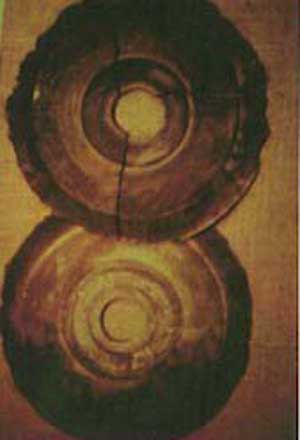

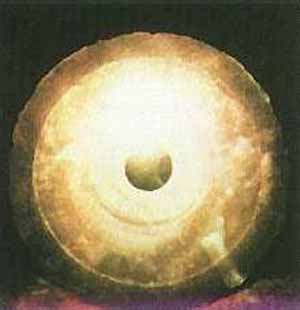
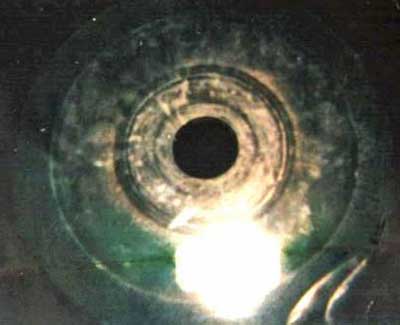
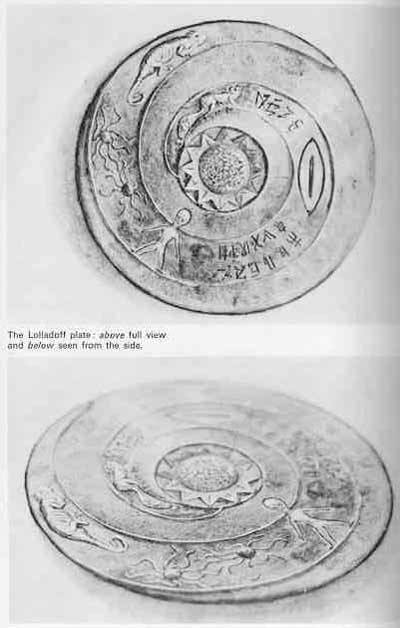
Each stone disk was reportedly inscribed with two fine grooves spiraling from
the edge to a hole in the disk's center, perhaps not unlike the Phaistos Disk.
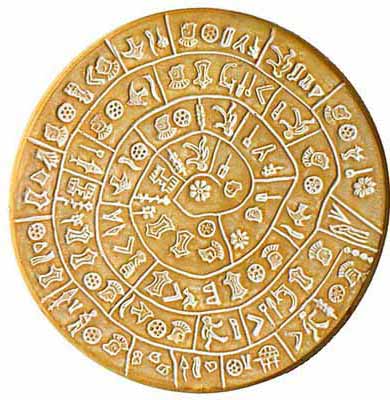
The disks were labeled along with other finds of the expedition and stored away at Beijing University for 20 years, during which deciphering attempts were unsuccessful. When the disks were closely examined by Dr. Tsum Um Nui of Beijing around 1958, he concluded that each groove actually consisted of a series of tiny hieroglyphs of unknown pattern and origin. The rows of hieroglyphics were so small that a magnifying glass was needed to see them clearly. Many of the hieroglyphics had been worn away by erosion. When Dr. Tsum deciphered the symbols, they told the story of the crash-landing of the Dropa spaceship and the killing of most of the survivors by local people.
According to Tsum Um Nui, one of the lines of the hieroglyphs reads, "The Dropas came down from the clouds in their aircraft. Our men, women and children hid in the caves ten times before sunrise. When at last they understood the sign language of the Dropas, they realized that the newcomers had peaceful intentions." Another section expresses "regret" by the Ham that the aliens' craft had crash-landed in such a remote and inaccessible mountain range and that there had been no way to building a new one to enable the Dropas to return to their own planet.
Dr. Tsum's report supposedly appeared in a professional journal in 1962. He was subsequently ridiculed to the point of self-imposed exile in Japan, where he died. The Peking Academy of Pre-history never allowed him to publish and never speak of his findings.
"Tsum Um Nui" is not a real Chinese name, and critics suggest that Dr. Tsum may not have actually existed. However Tsum Um Nui is a Japanese name adapted to Chinese language. There is no evidence of him beyond the Dropa allegations.
The records, some 716 grooved discs later uncovered in the same caves, tell an astonishing story of a space probe sent by the inhabitants of another planet. After landing at the Bayan-Kara-Ula mountain range, the scripts allegedly say, the peaceful intentions of the aliens confused the members of the Ham tribe, inhabitants of the neighboring caves, who hunted down and killed the extraterrestrials.
Photos claiming to show Dropa Disks are in fact Bi Disks, thousands of which have been found throughout China, mostly in the Southeastern Provinces. Bi Disks range in size of a few inches to several feet, and are most commonly made of jade or nephrite, with a round or square small central hole.
Most Bi Disks date to the Neolithic Period (c. 3000 BCE), but are found up to the Shang Dynasty Period. Bi Disks beyond the Shang Period are usually more ornate, carved with dragons, snakes and sometimes fish, and used in ritual ceremonies.
Most Neolithic Bi Disks were found in gravesites, buried beneath the head or feet of the deceased. It is theorized that this was to assist the deceased's spirit. No Bi Disks have been found to contain writing or spiral grooves as described in the Dropa story by authors such as Hartwig Hausdorf.
The Dropa Disks are said to be only 12 inches in diameter. However, one black and white photograph claimed by Hausdorf and others to display a Dropa Disk clearly shows the disk resting on a seat, and it is clearly several feet in diameter and has no markings whatsoever.
Wegerer asked the managers of Banpo-Museum for more information on the pieces in the showcase. The manager knew nothing of the stones' history, though she was able to tell a complete story about all the other artifacts made from clay. She only knew that the stone discs were unimportant "cult objects".
Wegerer was allowed to take one of the discs in his hand. He estimated their weight at 1 kilogram or 2 pounds, and the diameter at one foot. The hieroglyphs can't be seen in his photos, because they have crumbled away partly, and his camera's flash washed out the fine detail, such as the spiral grooves.
A few days after his visit, the manager was called away from her job without telling her why. She and the two stone discs vanished, according to Professor Wang Zhijun, the Director of the Banpo-Museum in March of 1994.
Legends supposedly still preserved in the area speak of small, gaunt, yellow-faced men who "came from the clouds, long, long ago". The men had huge, bulging heads and puny bodies and were so ugly and repellent that they were shunned by everyone. "Men with the quick horses" hunted down the ugly dwarfs. Strangely, the description of the "invaders" is said to match that of the skeletons originally discovered in the caves by Professor Chi Pu Tei.
No traceable, credible evidence for this theory exists, or can be proven to have existed in the past. Proponents of the Dropa-stones story claim that this is the result of social disruption caused by the Chinese Cultural Revolution and of a conspiratorial coverup by Chinese authorities. However this story goes well beyond China. Its opponents claim it is long proven to be a forgery by Erich von Daniken.
Below is a detailed rebuttal of most sensationalistic Extraterrestrial/Dropa claims:
- 1. The discovery. There are no mentions of 'Tsum Um Nui' anywhere; as he is supposed to have fled China and died in Japan in the 1960s this cannot be negated by Cultural Revolution, Communist coverup theory. Also, there is no mention of the 1938 archaeological expedition to the Banyan Kara Ulla range. No "Peking Academy of Pre-History" ever existed. 2. Early Sources. The earliest mention of the story is in Erich von Damien�s infamous 1968 book, Chariots of the Gods. The book has been widely criticized as unreliable; in fact, the vast majority of names and sources appearing in the book cannot be corroborated, and no existence of the following Soviet or Chinese scholars can be found anywhere outside this story: Cho Pu Tei, Tsum Um Nui, Ernst Wagener, Vyatcheslav Saizev, and Sergei Lolladoff. Most tellingly, D�niken gives his main source for the story as a Soviet science fiction writer Alexander Kazantsev; however Kazantsev himself disagrees with D�niken's account and says that it was D�niken who told him the story, not the other way around.
3. Later Sources. The 1978 book Sungods in Exile "edited" by David Agamon, appeared to lend support to the story of the Dropa, but Agamon admitted in the magazine Fortean Times in 1988 that the book was fiction and that its alleged author, a British researcher named Dr. Karyl Robin-Evans, was imaginary. Some websites claim to show a photo of Dr Robin-Evans with the Dalai Lama. A frail, old man assisted by the current Dalai Lama, the photograph is quite recent and can not be Dr Robin-Evans -- he died in 1978, according to Hartwig Hausdorf.
4. Translation. There is absolutely no precedent for an unknown language being successfully deciphered. All lost ancient languages have been rediscovered only because they survived in forms familiar to scientists. Even in such cases, deciphering and understanding these older language forms and their scripts has usually taken decades for multiple teams of highly competent linguists, and their findings are constantly being debated and updated. Many ancient scripts (notably Linear A from the island of Crete and Rongorongo from Easter Island), have defied deciphering precisely because they cannot be linked to any known language. Given these facts, there would be even greater difficulties in translating a truly extraterrestrial language. It is therefore highly unlikely that a single Chinese scholar with no reported background in linguistics could single-handedly decipher an alien script or language in his spare time.
5. The Disks. All that exists of the supposed alien disks are several wide-angle photographs. The disks photographed, firstly, do not match the described "12-inch disks"; the disks photographed are very large. Secondly, the photos show none of the supposed deep grooves. Finally, absolutely no photos, descriptions, analyses or any other evidence of the actual 'alien script' appear anywhere at all.
6. The Evidence. The disks were supposed to be stored in several museums in China. None of these museums have any traces of these disks, nor can any be found of the ones supposedly sent to USSR for analysis.
7. The Dropa Tribe. While reported to be a tribe of feeble dwarfs, in actuality the Dropas are nomadic herders who inhabit most of the northern Tibetan Plateau. The Ham are also inhabitants of Tibet, and traditionally have supplied Tibet's warriors: many of the 13th Dalai Lama's bodyguards during his escape from the Chinese invasion were Ham Tibetans. The word "Dropa", according to Chrieghton, describes the nomadic residents of Tibetan highlands, and can be roughly translated as "solitude" or "isolated". Furthermore, Chreighton described the Dropa as not resembling "troglodytes", or as stunted; on the contrary, they tend to be rather large and sturdy, befitting their occupation as herders. (Richie, 95-96)
Subscribe to:
Posts (Atom)